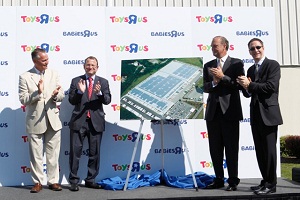Toys“R”Us' big new toy? Just one of the nation's largest rooftop solar arrays
 Some kids have to wait around until Christmas or their birthday to get their new favorite toy. But on August 11, the wait was over for Toys“R”Us. The company got a shiny new photovoltaic rooftop at its Flanders, N.J., warehouse.
Some kids have to wait around until Christmas or their birthday to get their new favorite toy. But on August 11, the wait was over for Toys“R”Us. The company got a shiny new photovoltaic rooftop at its Flanders, N.J., warehouse.
And at 5.38 megawatts, the solar array is among the largest currently operating in the U.S.—if it’s not the largest.
The rooftop array of amorphous silicon, Uni-Solar modules covers nearly 70 percent of the 1.3 million square-foot warehouse roof, according to a press release.
“Depending on weather conditions, the system is expected to produce approximately 6,362,000 kilowatt hours of electricity each year,” the release said.
“The best information we have is that it’s the largest at this point,” said Michael Smith, Constellation’s senior vice president of green initiatives. “It’s an ever-changing landscape.”
For instance, SunPower and Holt Logistics Group recently teamed up to start installing a 9 megawatt rooftop at the Gloucester Marine Terminal in New Jersey.
Toys “R” Us got the array thanks to a 20-year power-purchase agreement with Constellation Energy (NSYE: CEG). And, as a bonus, for the next three years, Constellation will purchase enough Green-e Certified renewable energy certificates (RECs) to offset 100 percent of the electricity used by Toys“R”Us’ Times Square flagship store with renewable power produced by wind turbines. That’s 7,500 certificates for the 7,064,800 kilowatt-hours of electricity typically needed to power the store annually.
Under the agreement Toys“R”Us will use all of the power produced by the installation, and Constellation will retain all the solar renewable energy credits (SRECs) produced by the system, according to Smith. The SRECs will help Constellation meet its renewable energy portfolio requirements in New Jersey.
“It’s a completely behind-the-meter system,” Smith said. “I expect they will be using 100 percent on site, but there will be some positive net metering.”
In all, the system is expected to generate 72 percent of the warehouse’s electrical needs, according to a press release. So in the daytime, it will be capable of providing more power than the warehouse needs at times, but the warehouse will need more power than the array can provide.
Image courtesy of Toys“R”Us.



